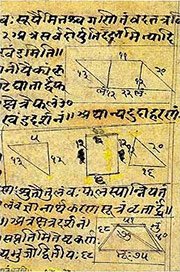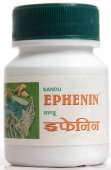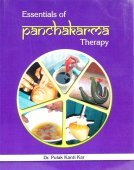Koshtha, Koṣṭha: 24 definitions
Introduction:
Koshtha means something in Hinduism, Sanskrit, Jainism, Prakrit, the history of ancient India, Marathi, Hindi, biology. If you want to know the exact meaning, history, etymology or English translation of this term then check out the descriptions on this page. Add your comment or reference to a book if you want to contribute to this summary article.
The Sanskrit term Koṣṭha can be transliterated into English as Kostha or Koshtha, using the IAST transliteration scheme (?).
Alternative spellings of this word include Koshth.
In Hinduism
Ayurveda (science of life)
Source: Wisdom Library: Āyurveda and botanyKoṣṭha (कोष्ठ) refers to “the bowel” or “the viscera”. The term is used throughout Ayurvedic literature such as the Suśruta-saṃhitā and the Caraka-saṃhitā. Koṣṭha is said to be one of the three “pathways of diseases” (rogamārga).
Source: gurumukhi.ru: Ayurveda glossary of termsKoṣṭha (कोष्ठ):—1. A closed space or area, typically indicative of organs in the abdominal, thoracic and pelvic cavities 2. Physiologically, koṣṭha is also indicative of gastro intestinal tract. Dependending on the dominance of Doṣa, depending on the ability to digest the food, and depending on the bowel movements, the koṣṭha of an individual can be classified as Krūra (hard bowel movements) Mṛdu (soft bowel movements) and Madhya (normal bowel movements).

Āyurveda (आयुर्वेद, ayurveda) is a branch of Indian science dealing with medicine, herbalism, taxology, anatomy, surgery, alchemy and related topics. Traditional practice of Āyurveda in ancient India dates back to at least the first millenium BC. Literature is commonly written in Sanskrit using various poetic metres.
Vastushastra (architecture)
Source: Wisdom Library: Vāstu-śāstraKoṣṭha (कोष्ठ) is a Sanskrit technical term denoting a “residence” in general, according to the lists of synonyms given in the Mānasāra XIX.108-12, which is a populair treatise on Vāstuśāstra literature.
Source: OpenEdition books: Architectural terms contained in Ajitāgama and RauravāgamaKoṣṭha (कोष्ठ) refers to “decorative aedicule (elongated) §§ 3.43; 4.10.”.—(For paragraphs cf. Les enseignements architecturaux de l'Ajitāgama et du Rauravāgama by Bruno Dagens)

Vastushastra (वास्तुशास्त्र, vāstuśāstra) refers to the ancient Indian science (shastra) of architecture (vastu), dealing with topics such architecture, sculpture, town-building, fort building and various other constructions. Vastu also deals with the philosophy of the architectural relation with the cosmic universe.
Jyotisha (astronomy and astrology)
Source: Wisdom Library: Brihat Samhita by VarahamihiraKoṣṭha (कोष्ठ) or Koṣṭhāgāra refers to “store houses”, according to the Bṛhatsaṃhitā (chapter 10), an encyclopedic Sanskrit work written by Varāhamihira mainly focusing on the science of ancient Indian astronomy astronomy (Jyotiṣa).—Accordingly, “If the course of Saturn should lie through the constellation of Āśleṣā, the creatures of water and serpents will suffer; if through the constellation of Maghā, the Bāhlīkas, the Cīna (Chinese), the people of Gāndhāra, of Śūlika, of Pārata, the Vaiáyas, store houses [i.e., koṣṭha-āgāra] and merchants will suffer. If his course should lie through the constellation of Pūrvaphālguni, juice-sellers, prostitutes, virgins and the people of Mahāraṣṭras will suffer miseries; if through Uttaraphālguni, kings, ascetics, jaggery, salt, water and the town of Takṣaśilā will suffer”.

Jyotisha (ज्योतिष, jyotiṣa or jyotish) refers to ‘astronomy’ or “Vedic astrology” and represents the fifth of the six Vedangas (additional sciences to be studied along with the Vedas). Jyotisha concerns itself with the study and prediction of the movements of celestial bodies, in order to calculate the auspicious time for rituals and ceremonies.
Ganitashastra (Mathematics and Algebra)
Source: archive.org: Hindu MathematicsKoṣṭha (कोष्ठ) represents the number 4 (four) in the “word-numeral system” (bhūtasaṃkhyā), which was used in Sanskrit texts dealing with astronomy, mathematics, metrics, as well as in the dates of inscriptions and manuscripts in ancient Indian literature.—A system of expressing numbers by means of words arranged as in the place-value notation was developed and perfected in India in the early centuries of the Christian era. In this system the numerals [e.g., 4—koṣṭha] are expressed by names of things, beings or concepts, which, naturally or in accordance with the teaching of the Śāstras, connote numbers.

Ganitashastra (शिल्पशास्त्र, gaṇitaśāstra) refers to the ancient Indian science of mathematics, algebra, number theory, arithmetic, etc. Closely allied with astronomy, both were commonly taught and studied in universities, even since the 1st millennium BCE. Ganita-shastra also includes ritualistic math-books such as the Shulba-sutras.
Yoga (school of philosophy)
Source: ORA: Amanaska (king of all yogas): A Critical Edition and Annotated Translation by Jason BirchKoṣṭha (कोष्ठ) refers to “abdomen” and represents a synonym for Udara (stomach/abdomen), according to the Hemacandra’s Yogaśāstra (verse 5.6); Cf. Pātañjalayogaśāstra (verse 1.31).—Accordingly, “That external emission of the breath, [which is performed] with intense effort [and flows] from the abdomen (koṣṭha) through the nose, the crown of the head and mouth, is considered to be the exhalation”.
Note: In his auto-commentary (the Svopajñavṛtti) on Yogaśāstra 5.6, Hemacandra glosses koṣṭhāt as udarāt (i.e., the stomach/abdomen). The term koṣṭha also occurs in Yogayajñavalkya 4.62: and Gheraṇḍasaṃhitā 1.49a-b. [...]

Yoga is originally considered a branch of Hindu philosophy (astika), but both ancient and modern Yoga combine the physical, mental and spiritual. Yoga teaches various physical techniques also known as āsanas (postures), used for various purposes (eg., meditation, contemplation, relaxation).
In Jainism
General definition (in Jainism)
Source: Encyclopedia of Jainism: Tattvartha Sutra 3: The Lower and middle worldsKoṣṭha (कोष्ठ, “search”) refers to “search-intellect” and represents one of the eighteen types of extraordinary intellect (buddhi), which itself is a subclass of the eight ṛddhis (extraordinary powers). These powers can be obtained by the Ārya (civilized people) in order to produce worldly miracles. The Āryas represent one of the two classes of human beings according to the 2nd-century Tattvārthasūtra 3.46, the other being Mleccha (barbarians).
What is meant by extraordinary store intellect (koṣṭha-buddhi-riddhi)? The intellect which can extract any quotes /aphorism from different scriptures when required is called super natural search-intellect. To understand this it is like the capability to take out something from the storehouse having a vast variety of goods.

Jainism is an Indian religion of Dharma whose doctrine revolves around harmlessness (ahimsa) towards every living being. The two major branches (Digambara and Svetambara) of Jainism stimulate self-control (or, shramana, ‘self-reliance’) and spiritual development through a path of peace for the soul to progess to the ultimate goal.
India history and geography
Source: Cologne Digital Sanskrit Dictionaries: Indian Epigraphical GlossaryKoṣṭha.—(IE 7-1-2), ‘four’. Cf. koṣṭhaka. Note: koṣṭha is defined in the “Indian epigraphical glossary” as it can be found on ancient inscriptions commonly written in Sanskrit, Prakrit or Dravidian languages.

The history of India traces the identification of countries, villages, towns and other regions of India, as well as mythology, zoology, royal dynasties, rulers, tribes, local festivities and traditions and regional languages. Ancient India enjoyed religious freedom and encourages the path of Dharma, a concept common to Buddhism, Hinduism, and Jainism.
Biology (plants and animals)
Source: Google Books: CRC World Dictionary (Regional names)Koshtha in India is the name of a plant defined with Saussurea costus in various botanical sources. This page contains potential references in Ayurveda, modern medicine, and other folk traditions or local practices It has the synonym Aucklandia lappa Decne. (among others).
Example references for further research on medicinal uses or toxicity (see latin names for full list):
· Botanicheskii Zhurnal (1964)
· Iconographia Cormophytorum Sinicorum (6700)
· Fl. Yunnan. (2003)
· Compositae Indicae (1876)
· Dict. Sci. Nat. (1827)
· Revisio Generum Plantarum (1891)
If you are looking for specific details regarding Koshtha, for example side effects, diet and recipes, pregnancy safety, health benefits, extract dosage, chemical composition, have a look at these references.

This sections includes definitions from the five kingdoms of living things: Animals, Plants, Fungi, Protists and Monera. It will include both the official binomial nomenclature (scientific names usually in Latin) as well as regional spellings and variants.
Languages of India and abroad
Marathi-English dictionary
Source: DDSA: The Molesworth Marathi and English Dictionarykōṣṭha (कोष्ठ).—m S The stomach. 2 A granary. 3 An apartment.
Source: DDSA: The Aryabhusan school dictionary, Marathi-Englishkōṣṭha (कोष्ठ).—m The stomach. A granary. An apartment.
Marathi is an Indo-European language having over 70 million native speakers people in (predominantly) Maharashtra India. Marathi, like many other Indo-Aryan languages, evolved from early forms of Prakrit, which itself is a subset of Sanskrit, one of the most ancient languages of the world.
Sanskrit dictionary
Source: DDSA: The practical Sanskrit-English dictionaryKoṣṭha (कोष्ठ).—a. [kuṣ-than Uṇādi-sūtra 2.4] Own.
-ṣṭhaḥ 1 Any one of the viscera of the body, such as the heart, lungs &c.
2) The belly, abdomen; आकोष्ठं ज्यां समुत्कृष्य (ākoṣṭhaṃ jyāṃ samutkṛṣya) Bhāgavata 1. 83.22.
3) An inner apartment.
4) A granary, storeroom; कन्दुः कोष्ठः कुशूलः (kanduḥ koṣṭhaḥ kuśūlaḥ) Mahābhārata on P.I.2.45. etc.
-ṣṭham 1 A surrounding wall; Bhāgavata 4.28.56.
2) The shell of anything.
Source: Cologne Digital Sanskrit Dictionaries: Edgerton Buddhist Hybrid Sanskrit DictionaryKoṣṭha (कोष्ठ).—(ka) , see caraṇa-, dvāra-k°.
Source: Cologne Digital Sanskrit Dictionaries: Shabda-Sagara Sanskrit-English DictionaryKoṣṭha (कोष्ठ).—mfn.
(-ṣṭhaḥ-ṣṭhā-ṣṭhaṃ) Own. m.
(-ṣṭhaḥ) 1. A granary, a place in which grain is kept. 2. A treasury. 3. An apartment. 4. Any viscus, as the heart, lungs, stomach, bowels, &c. E. kuṣ to issue, than Unadi aff.
Source: Cologne Digital Sanskrit Dictionaries: Benfey Sanskrit-English DictionaryKoṣṭha (कोष्ठ).—I. m. The stomach, Mahābhārata 14, 570. Ii. m. and n. 1. A granary. 2. A store-room, Mahābhārata 2, 201. Iii. n. A wall, [Bhāgavata-Purāṇa, (ed. Burnouf.)] 4, 28, 56.
Source: Cologne Digital Sanskrit Dictionaries: Cappeller Sanskrit-English DictionaryKoṣṭha (कोष्ठ).—[masculine] the bowels or the belly (also [neuter]), a kind of vessel or pot; [neuter] store-room, surrounding wall.
Source: Cologne Digital Sanskrit Dictionaries: Monier-Williams Sanskrit-English Dictionary1) Koṣṭha (कोष्ठ):—m. (√kuṣ?; probably related to kukṣi and kośa), any one of the viscera of the body (particularly the stomach, abdomen), [Mahābhārata; Suśruta] etc.
2) mn. (as, [cf. Lexicographers, esp. such as amarasiṃha, halāyudha, hemacandra, etc.]; am) a granary, store-room, [Mahābhārata; Bhāgavata-purāṇa] (ifc. f(ā). )
3) a treasury, [Horace H. Wilson]
4) m. an inner apartment, [cf. Lexicographers, esp. such as amarasiṃha, halāyudha, hemacandra, etc.]
5) the shell of anything, [Horace H. Wilson]
6) a kind of pan, pot, [Kauśika-sūtra; Patañjali; Caraka; Bhāvaprakāśa]
7) m. property (or mfn. ‘own’), [cf. Lexicographers, esp. such as amarasiṃha, halāyudha, hemacandra, etc.]
8) m. night, [cf. Lexicographers, esp. such as amarasiṃha, halāyudha, hemacandra, etc.]
9) n. a surrounding wall, [Bhāgavata-purāṇa iv, 28, 57]
10) any enclosed space or area, chess square, [Varāha-mihira’s Bṛhat-saṃhitā liii, 42; Hemādri’s Caturvarga-cintāmaṇi; Tithyāditya; Kātyāyana-śrauta-sūtra [Scholiast or Commentator]]
Source: Cologne Digital Sanskrit Dictionaries: Yates Sanskrit-English DictionaryKoṣṭha (कोष्ठ):—(ṣṭhaṃ) 1. m. A granary.
Source: DDSA: Paia-sadda-mahannavo; a comprehensive Prakrit Hindi dictionary (S)Koṣṭha (कोष्ठ) in the Sanskrit language is related to the Prakrit words: Kuṭṭha, Koṭṭha.
[Sanskrit to German]
Sanskrit, also spelled संस्कृतम् (saṃskṛtam), is an ancient language of India commonly seen as the grandmother of the Indo-European language family (even English!). Closely allied with Prakrit and Pali, Sanskrit is more exhaustive in both grammar and terms and has the most extensive collection of literature in the world, greatly surpassing its sister-languages Greek and Latin.
Hindi dictionary
Source: DDSA: A practical Hindi-English dictionaryKoṣṭha (कोष्ठ) [Also spelled koshth]:—(nm) an apartment, a chamber; stomach; bracket; ~[baddhatā] constipation; ~[śuddhi] purgation.
...
Kannada-English dictionary
Source: Alar: Kannada-English corpusKōṣṭha (ಕೋಷ್ಠ):—[noun] = ಕೋಷ್ಟ - [koshta -]1, 3 & 4.
--- OR ---
Kōṣṭha (ಕೋಷ್ಠ):—
1) [noun] the internal organs of the body, esp. of the thorax and abdomen, as the heart, lungs, liver, kidneys, intestines, etc.; the viscera.
2) [noun] an inner apartment of a house.
3) [noun] a store-house for threshed grain; a granary.
4) [noun] the portion just below the anus of a horse.
5) [noun] a single thickness, coat, fold or stratum; a layer.
6) [noun] one of the squares, in a table of calculation.
7) [noun] a wall surrounding a building or a place.
8) [noun] a single thickness, coat, fold or stratum.
Kannada is a Dravidian language (as opposed to the Indo-European language family) mainly spoken in the southwestern region of India.
See also (Relevant definitions)
Starts with (+16): Koshtha-karana, Koshtha-vyapara, Koshthabandhaka, Koshthabheda, Koshthadosha, Koshthagara, Koshthagara-karana, Koshthagaravatamsaka, Koshthagarika, Koshthagarin, Koshthagni, Koshthak, Koshthaka, Koshthakacihna, Koshthakacintamanitika, Koshthakasthi, Koshthaki, Koshthakigunakara, Koshthakikri, Koshthakikritya.
Ends with (+15): Amkoshtha, Annakoshtha, Arikoshtha, Baddhakoshtha, Bhadrakoshtha, Camgalakoshtha, Camgalanirakoshtha, Dvarakoshtha, Dvaraprakoshtha, Garbhakoshtha, Hemakamkoshtha, Indrakoshtha, Kamakoshtha, Kamkoshtha, Konakoshtha, Krurakoshtha, Kutakoshtha, Laghukoshtha, Madhyamakoshtha, Mridukoshtha.
Full-text (+80): Krurakoshtha, Kuttha, Koshthagara, Mridukoshtha, Koshthapala, Koshthaka, Koshthya, Koshthagni, Mallakoshta, Prakoshtha, Kottha, Koshthashuddhi, Koshthakoti, Annakoshtha, Koshthila, Koshthika, Koshthagarika, Kaushtha, Changal kostha, Akoshtham.
Relevant text
Search found 30 books and stories containing Koshtha, Koṣṭha, Kostha, Kōṣṭha; (plurals include: Koshthas, Koṣṭhas, Kosthas, Kōṣṭhas). You can also click to the full overview containing English textual excerpts. Below are direct links for the most relevant articles:
Temples of Munnur (Historical Study) (by R. Muthuraman)
Amarakoshodghatana of Kshirasvamin (study) (by A. Yamuna Devi)
Town Planning (4): Other Constructions < [Chapter 3 - Social Aspects]
The Garuda Purana (by Manmatha Nath Dutt)
Chapter CLXXXIX - The Nidanam of traumatic ulcers etc < [Dhanvantari Samhita]
Chapter CXCIII - Medical treatment of fever etc < [Dhanvantari Samhita]
Kashyapa Shilpa-shastra (study) (by K. Vidyuta)
5. Measurement for the Storeys of the Gopuras < [Chapter 5 - Gopura Lakṣaṇa]
4 (b). Technical terms for the component parts of the temple < [Chapter 2 - Author and his Works]
8. Śālā, Sabhā and Mālikā-kāra Lakṣaṇas < [Chapter 5 - Gopura Lakṣaṇa]
Manasara (English translation) (by Prasanna Kumar Acharya)
Chapter 33a - The gatehouses (gopura)
Chapter 25 - The seven-storeyed buildings (saptatala or saptabhūmi)
Chapter 27 - The nine-storeyed buildings (navatala or navabhūmi)
Sushruta Samhita, volume 4: Cikitsasthana (by Kaviraj Kunja Lal Bhishagratna)
Related products


